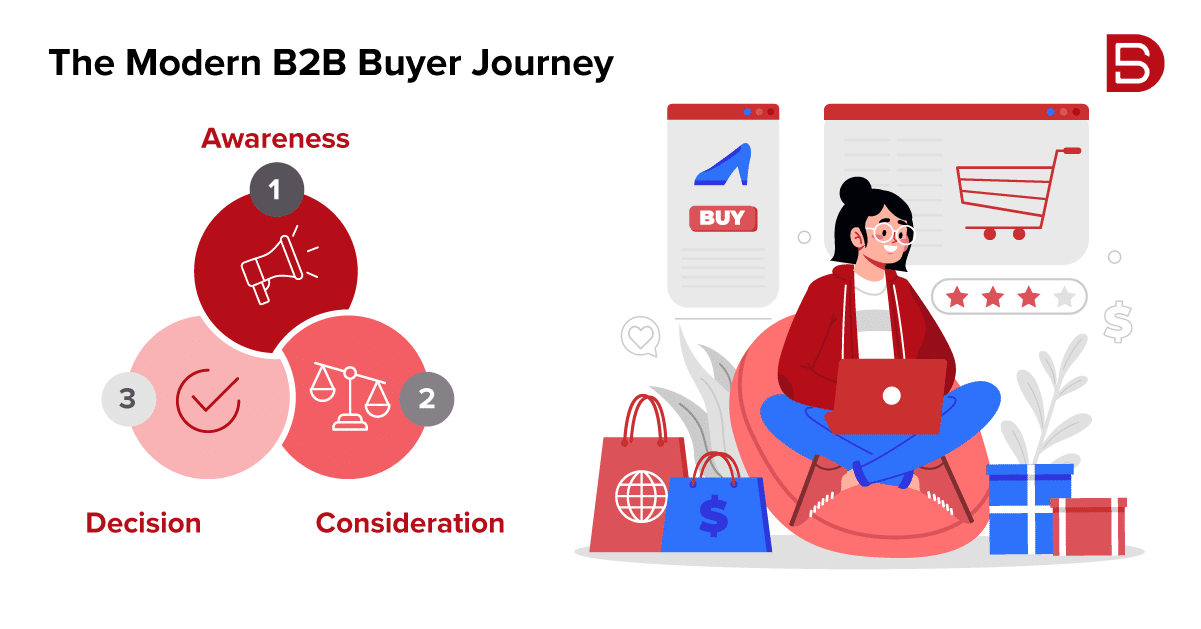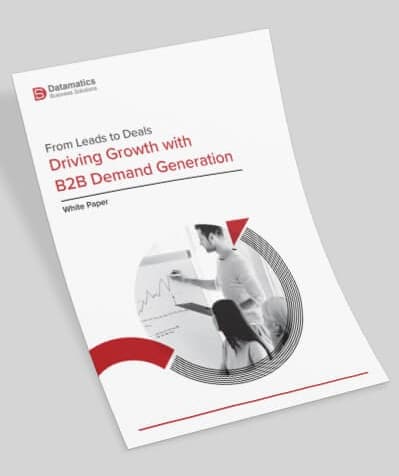The B2B buyer’s journey isn’t what it used to be. Traditional sales tactics are out the window, with buyers now more informed about products and services than ever before. This change poses a challenge for B2B marketers. How do you guide prospects from awareness to purchase when they have so much information at their fingertips?
In this blog, we will break down the modern B2B buying journey and share tips on how to update your marketing strategies for today’s landscape. Keep reading for the ultimate guide to the B2B buyer’s journey.
Understanding the Modern B2B Buyer’s Journey
The B2B buyer journey is the series of steps a buyer takes from realizing they have a problem to finding the best solution. By the time a buyer requests a product/service demo, they have already done their fair share of research. They have Googled your brand and compared it to others. Infact, according to SiriusDecisions, 67% of the buyer journey is now completed digitally.
Understanding the intricacies of the B2B buyer journey is pivotal in addressing this challenge and optimizing your B2B marketing strategy. When marketers grasp their buyers’ needs, preferences, and search behaviors, they can craft more targeted and effective strategies to engage prospects and guide them through the purchasing journey.
- Enhance the buyer experience.
- Demonstrate the value of your product or service.
- Boost their win rates.
- Guide prospects efficiently through the sales funnel.
From a broader perspective, the B2B buyer journey unfolds in three key stages:
1. Awareness Stage
This is when the buyer first realizes they have a problem or a need that requires attention.
2. Consideration Stage
Here, the buyer clearly defines their problem and begins researching potential solutions that could address their specific needs.
3. Decision Stage
In this final stage, the buyer evaluates the available options, compares them against each other, and ultimately makes a decision on which solution to proceed with.
When comparing the buyer journey with the traditional sales process, it’s clear where many sales teams struggle. Instead of offering generic product-focused messages, successful teams prioritize understanding their customers’ journey and delivering tailored guidance and support at each step. Investing in effective marketing automation strategies and mastering the art of guiding buyers through their journey can significantly enhance sales outcomes.
Let’s dive into how you can synchronize your sales strategy with the marketing journey:
Aligning Your Marketing Strategy with the Buyer’s Journey
1. Creating Awareness of Need
At the beginning, buyers become aware of a challenge or opportunity they need to address. They are evaluating whether it’s critical enough to act. For instance, they might recognize the importance of improving sales data accuracy.
Marketing plays a crucial role here by raising awareness about your product, service, or company. Focus on educating buyers about their specific challenges and how your solutions can solve their problems. This means creating content that speaks directly to their concerns rather than just promoting your products.
Using social media platforms to share valuable insights and content can effectively build awareness and establish your brand as a knowledgeable resource in your industry.
2. Guide Your Buyers
Once buyers recognize their challenges, their research journey kicks off. Initially, they start by exploring broad search terms to weigh their options. During this phase, they actively seek out educational materials, customer reviews, online courses, and testimonials.
As they delve deeper into their research, they begin to distinguish which solutions align best with their needs. They might discard options that don’t fit their criteria and focus on a handful of competing companies.
At this critical stage, they also:
- Clearly define the specific outcomes they expect from a new vendor or provider.
- Identify the key stakeholders involved in the decision-making process.
- Outline how they will measure success, both in the short term and long term.
Armed with this knowledge, they often proceed to draft a Request for Proposal (RFP) and set a budget.
Educational content such as whitepapers, reports, surveys, and case studies become invaluable here. Ensure these resources are easily accessible on your website and use lead nurturing campaigns to systematically deliver this content to your prospects. This approach helps guide them through their decision-making journey effectively.
3. Effectively Qualify Your Buyers
At this stage, buyers have pinpointed their goals or challenges and are determined to find a solution. After narrowing down their choices to a few companies, they dive deeper into each one’s offerings to see how well they meet their specific needs.
During this phase, buyers reach out to companies for more information or personalized product or service demos. They want to understand how your solution can directly benefit their teams.
As more stakeholders join the decision-making process, different viewpoints and priorities come into play, influencing decision criteria and requirements. This often leads to discussions focusing on ROI and long-term benefits.
To stay aligned with their evolving needs, it’s important to update their lead scores in your marketing automation tool as they progress through their research.
4. Demonstrate Your Products’/Services’ ROI
At this stage of the journey, B2B buyers, who aren’t always the final decision-makers, often need to secure approval from their managers. To convince C-suite colleagues to sign off on your solution, buyers seek content that addresses pricing and return on investment (ROI). They need to make a compelling case for investing in your brand.
When creating content for this phase, it’s essential to speak the language of the C-suite. Avoid technical jargon and focus on straightforward facts; use numbers, statistics, case studies and testimonials that clearly demonstrate ROI and value for money.
Proving the value of your solution is crucial. You must show the buyer your solution is the best choice among competitors.
5. Assist Buyers in Decision-Making
Once your buyers have obtained approval from the C-suite, they are ready to choose a vendor and make a purchase. At this stage, they start considering preparation, implementation costs, quick start options, and customer support; all critical factors in determining which solution best fits their needs and budget.
Cost becomes a significant consideration now. Buyers weigh the risks of maintaining the status quo versus the risks associated with selecting the wrong solution. They seek assurance that implementation will be efficient and seamless.
This is the ideal moment to provide tailored content about your brand. Highlight a variety of case studies and customer testimonials that illustrate the successful outcomes and positive experiences achieved by choosing your solution.
6. Ensure a Seamless Transition
Congratulations! You’ve closed the deal, and your new customers are eager to experience the value your product offers. But the journey doesn’t end there. A smooth onboarding process sets the stage for long-term success and happy customers. Focus on value, not price. Pricing discussions and negotiations are natural at this stage. Customers might request lower prices to minimize risk.
While other departments within their company analyze the total cost of ownership (including both upfront and ongoing expenses) of your solution, your champions will be busy researching best practices and implementation guides. Their goal? To get the most out of your product quickly.
Here’s where a well-designed drip nurturing program comes in. This automated email series delivers targeted content that helps your new customers navigate the implementation process, maximize product effectiveness, and ultimately achieve their desired outcomes.
By providing ongoing support and valuable resources, you’ll not only ensure a smooth transition but also reinforce the perceived value of your product. This, in turn, increases customer satisfaction and loyalty, making them more likely to renew with you when the time comes.
Be Free and Powerful
The days of forceful sales tactics are over. Today’s buyers are in control, and they expect a smooth, informative journey. This isn’t just a marketing trend; it’s a fundamental shift in power. By understanding your buyer’s journey, you can anticipate their needs and provide valuable resources at each stage. The good news: it’s a win-win! By tailoring your marketing to each stage of the buyer’s path, you can meet their needs and build lasting relationships.
Want to transform your demand generation efforts and become a master of the buyer’s journey? We can help! Write to us at marketing@datamaticsbpm.com and let’s discuss how to craft a winning strategy for your business.
 Select an element to maximize. Press ESC to cancel.
Select an element to maximize. Press ESC to cancel.
James Libera




